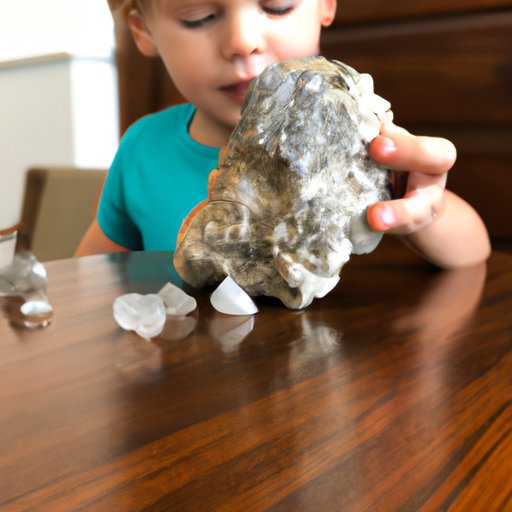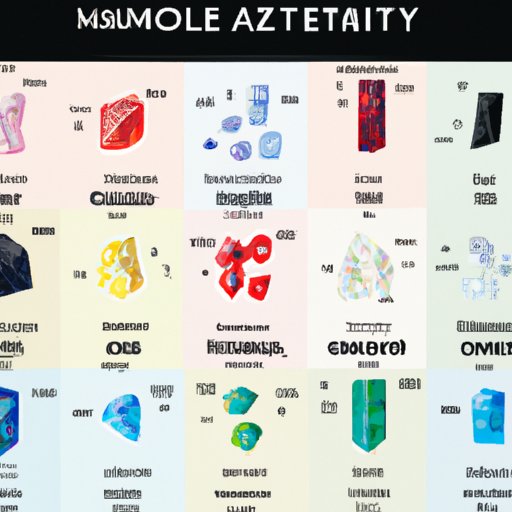Introduction
Minerals are naturally occurring substances that make up rocks and other geological formations. They are made up of unique chemical compositions and physical properties, including color, texture, and hardness. The hardness of a mineral is determined by its ability to resist scratching or abrasion. In this article, we will explore what mineral is the hardest and how its hardness is measured.

A Comparison of the Hardness Levels of Common Minerals
To measure the hardness of a mineral, geologists use the Mohs scale of hardness. Developed in 1812 by German mineralogist Friedrich Mohs, the scale ranges from 1 (the softest) to 10 (the hardest). Each point on the scale represents a different mineral. For example, talc has a hardness of 1, while diamond has a hardness of 10. Other common minerals and their hardness levels include:
- Quartz (7)
- Topaz (8)
- Corundum (9)
- Diamond (10)
The Science Behind Determining the Hardest Mineral
So, what makes one mineral harder than another? To understand this, it’s important to look at the internal structure of a mineral. As noted by geologist Dr. Mark J. Dekay, “The strength of each mineral is determined by the covalent bonding between atoms within the mineral.”
In simpler terms, minerals are composed of atoms bonded together. When these bonds are strong, the mineral will be hard. If the bonds are weak, the mineral will be softer. For example, diamond has a very strong covalent bond between its carbon atoms, making it the hardest known mineral.

Exploring the Properties of the Hardest Mineral
Once the hardest mineral is identified, it’s important to consider its properties. Generally speaking, harder minerals tend to be more durable, abrasive, and chemically resistant. Let’s take a closer look at each of these properties:
Abrasiveness
Harder minerals are often used in industrial applications because they are more abrasive. This means they can withstand greater amounts of pressure without breaking down. For example, diamond is used to cut through metal and other materials due to its hardness.
Durability
Harder minerals are also more durable than softer ones. This makes them ideal for use in jewelry and other items that need to stand up to daily wear and tear. Diamond is the perfect example of this – it’s one of the most durable minerals on Earth.
Chemical Composition
The chemical composition of a mineral can also affect its hardness. Minerals with a higher concentration of certain elements, such as silicon and aluminum, tend to be harder than those with lower concentrations.
How a Mineral’s Hardness is Measured
The hardness of a mineral can be measured using various tests. Here are three of the most common:
Scratch Tests
One of the simplest ways to measure a mineral’s hardness is with a scratch test. In this test, a mineral is scratched with an object of known hardness. If the object leaves a mark, the mineral is softer than the object. If the object does not leave a mark, the mineral is harder than the object.
Vickers Hardness Test
The Vickers Hardness Test measures the amount of force required to indent a mineral. A diamond-tipped indenter is used to press into the surface of the mineral. The depth of the indentation is then measured and used to determine the mineral’s hardness.
Knoop Hardness Test
The Knoop Hardness Test is similar to the Vickers Hardness Test, but uses a diamond-tipped indenter that is shaped like a pyramid. This test is particularly useful for measuring the hardness of brittle materials like ceramics and glass.
The World’s Top Ten Hardest Minerals
Now that we’ve explored the science behind measuring a mineral’s hardness, let’s take a look at the world’s top ten hardest minerals:
- Diamond (10)
- Corundum (9)
- Topaz (8)
- Quartz (7)
- Chrysoberyl (8.5)
- Spinel (8)
- Garnet (7.5-8)
- Calcite (3)
- Apatite (5)
- Feldspar (6)

The Benefits of Using Harder Minerals
Using harder minerals in commercial and industrial applications can provide a number of benefits, including:
Increased Durability
Harder minerals are more durable than softer minerals, meaning they can withstand greater amounts of pressure and wear and tear. This increased durability makes them ideal for use in products that require long-term performance.
Enhanced Abrasion Resistance
Harder minerals are also more resistant to abrasion, which means they can be used in a variety of industrial processes. For example, diamond is often used to cut and shape metals and other materials.
Improved Chemical Resistance
Harder minerals are less likely to react with chemicals, making them ideal for use in environments where corrosive materials are present. This makes them a popular choice for laboratory equipment and other scientific applications.
Conclusion
In conclusion, hardness is an important property of minerals that helps to determine their suitability for different applications. We’ve explored the different types of minerals and their hardness levels, as well as what makes a mineral hard and how its hardness is measured. Finally, we’ve looked at the world’s top ten hardest minerals and the benefits of using harder minerals. Ultimately, understanding the hardness of minerals is key to choosing the right material for any project.
(Note: Is this article not meeting your expectations? Do you have knowledge or insights to share? Unlock new opportunities and expand your reach by joining our authors team. Click Registration to join us and share your expertise with our readers.)
